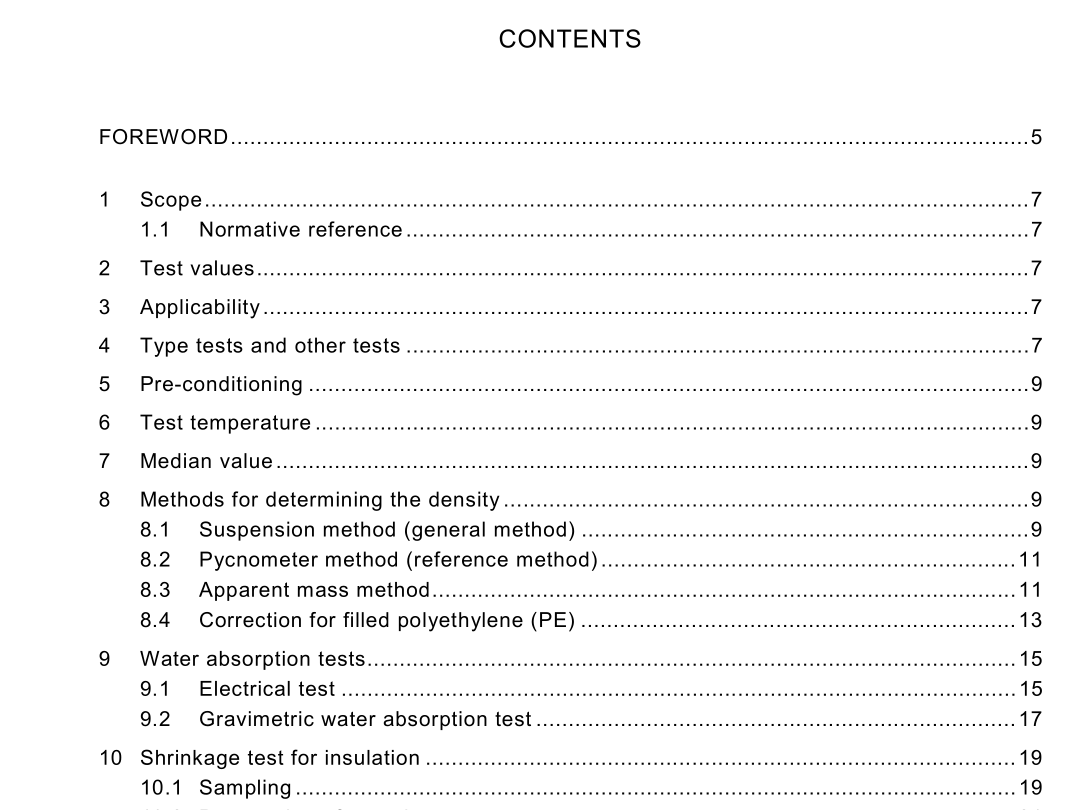IEC 60811-1-3 pdf download

IEC 60811-1-3 pdf download.Common test methods for insulating and sheathing materials of electric and optical cables
1 Scope
This section of IEC 6081 1 -1 specifies the test methods to be used for testing polymeric insulating and sheathing materials of electric cables for power distribution and telecom- munications including cables used on ships and in offshore applications. This section three of part 1 gives the methods for determining the density, water absorption tests and shrinkage test which apply to the most common types of insulating and sheathing compounds (elastomeric, PVC, PE, PP, etc.). 1.1 Normative reference The following normative document contain provisions which, through reference in this text, constitute provisions of this part of IEC 6081 1 . For dated references, subsequent amend- ments to, or revisions of, any of these publications do not apply. However, parties to agreements based on this part of IEC 6081 1 are encouraged to investigate the possibility of applying the most recent editions of the normative documents indicated below. For undated references, the latest edition of the normative document referred to applies. Members of IEC and ISO maintain registers of currently valid International Standards. ISO 1 1 83:1 987, Plastics – Methods for determining the density and relative density of non- cellular plastics
2 Test values
Full test conditions (such as temperatures, durations, etc.) and full test requirements are not specified in this standard; it is intended that they should be specified by the standard dealing with the relevant type of cable. Any test requirements which are given in this standard may be modified by the relevant cable standard to suit the needs of a particular type of cable.
3 Applicability
Conditioning values and testing parameters are specified for the most common types of insulating and sheathing compounds and of cables, wires and cords.
4 Type tests and other tests
The test methods described in this standard are intended, in the first instance, to be used for type tests. In certain tests, where there are essential differences between the conditions for type tests and those for more frequent tests, such as routine tests, these differences are indicated.
8 Methods for determining the density
8.1 Suspension method (general method) 8.1 .1 Testing materials and equipment 1 ) Ethanol (ethyl-alcohol) of analytical grade or another suitable liquid for densities below 1 g/ml. 2) Zinc chloride solution for densities equal to or greater than 1 g/ml. 3) Distilled or deionized water. 4) Mixing cylinder. 5) Thermostat. 6) Hydrometer calibrated at (23,0 ± 0,1 ) °C. 7) Thermometer graduated in tenths of a degree Celsius. 8.1 .2 Procedure 8.1.2.1 From the insulation or the sheath to be tested, a sample shall be taken perpendicularly to the conductor axis and cut into small pieces of 1 mm to 2 mm edge length. The density shall be determined by putting the sample in suspension in a liquid which does not react with the material to be tested. The following liquids are suitable: – for a density expected to be lower than 1 g/ml, a mixture of ethanol and water; – for a density of 1 g/ml and higher, a mixture of zinc chloride and water. 8.1.2.2 Three pieces of the sample shall be placed in the liquid at a temperature of (23,0 ± 0,5) °C, avoiding any formation of air bubbles. Distilled water shall be added to the liquid until the pieces are freely suspended within the liquid in the mixing cylinder. The liquid mixture shall be homogeneous and maintained at the indicated temperature. The density of the liquid mixture shall be determined by means of the hydrometer and indicated to three decimal places; the determined density is the same as that of the samples under test. NOTE The gradient method specified in ISO 1 1 83 may also be used.









